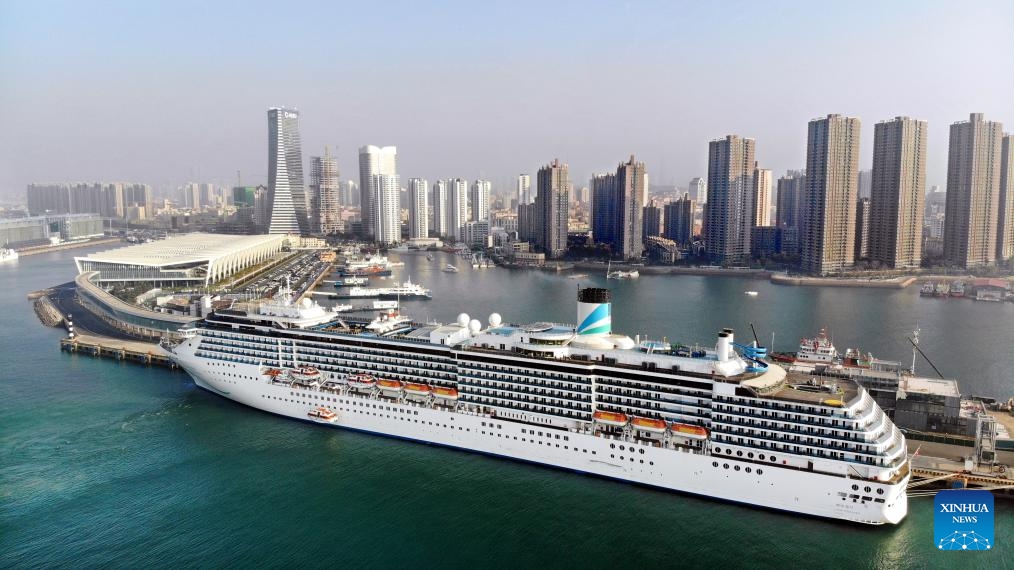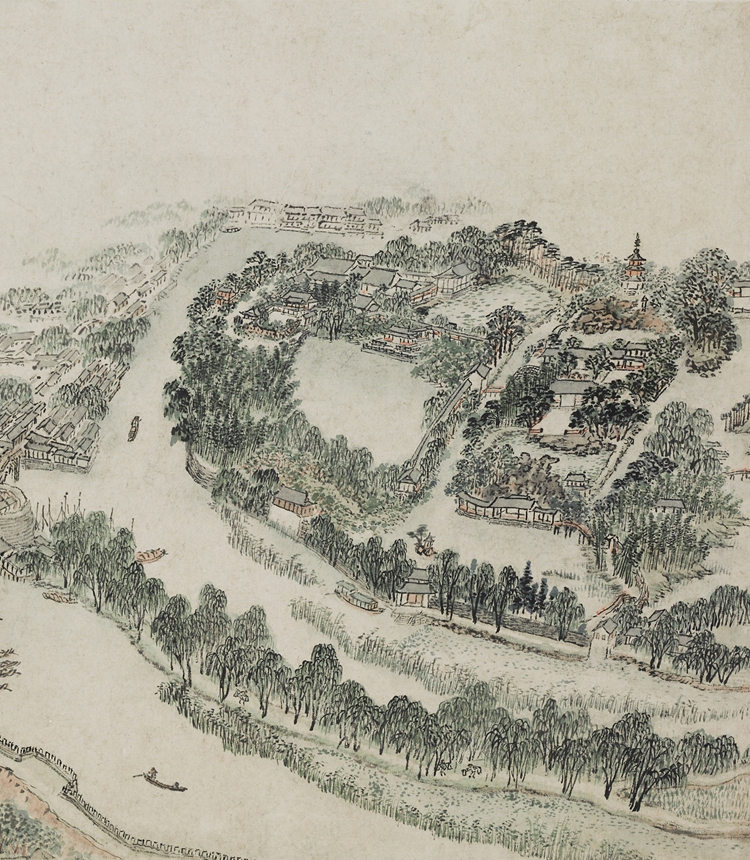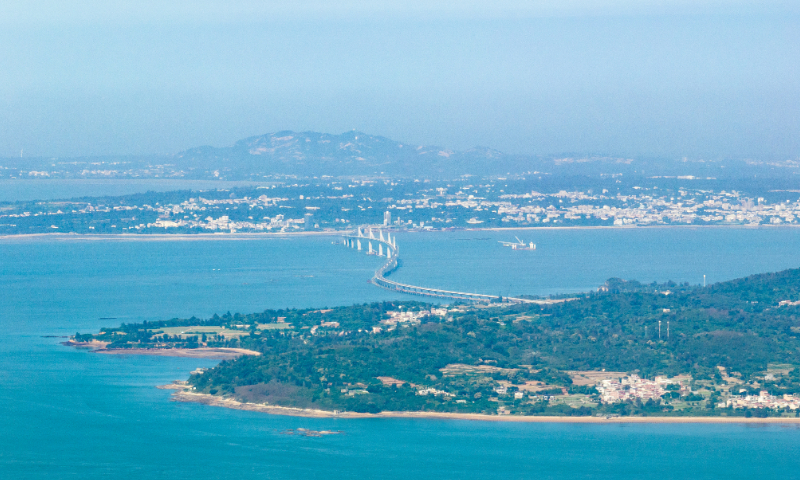China to launch “2024 Spring Breeze” plan, aiming to create 30 million jobs from late Jan to early Apr: ministry
China to launch “2024 Spring Breeze” plan, aiming to create 30 million jobs from late Jan to early Apr: ministry
China to launch “2024 Spring Breeze” plan, aiming to create 30 million jobs from late Jan to early Apr: ministry

Chipmaking equipment producer ASML on Wednesday announced better-than-expected results for the fourth quarter and full year of 2023, while warning that US export controls would affect its sales in China by 10-15 percent in 2024.
For 2023, ASML reported 27.6 billion euros ($30 billion) in revenue, up 30 percent year-on-year. Its gross profit margin was 51.3 percent, with a net profit of 7.8 billion euros, and the unshipped order backlog reached 39 billion euros.
Business with China in 2023 was extremely robust and strong, Roger Dassen, executive vice president and chief financial officer of ASML, said in a statement sent to the Global Times on Wednesday.
The Dutch company has been caught in the broader technology battle between the US and China. On January 2, ASML said that the Dutch government had partially revoked an export license for the shipment of some chipmaking equipment to China, following US export restrictions.
Exports of NXT:2050i and NXT:2100i lithography systems in 2023 were affected, the company said.
"It can be anticipated that in 2024, we will not obtain export licenses for shipping NXT:2000i and higher immersion equipment to China. Additionally, certain advanced chip manufacturing wafer fabs in China will be unable to obtain licenses for shipping NXT:1970i and NXT:1980i immersion equipment," Dassen said.
ASML previously said that the US export restrictions would affect 10-15 percent of China sales. There would be a similar impact in 2024, Dassen said.
"However, we can still observe strong demand in the mature process markets within the end-user market," said Dassen.
The US containment strategy related to high-end chips has failed to prevent Chinese companies from making their own 5G models, so it tightened the curbs, Zhang Hong, a veteran industry observer, told the Global Times on Wednesday.
Zhang noted that the move will only disrupt global industry chains and hit global technology giants' profits, and cause them to lose market shares in China.
In response to the Dutch government's blocking of ASML exports to China, Chinese Foreign Ministry spokesperson Wang Wenbin on January 2 said that China strongly opposes the hegemonic and bullying practices of the US, which seriously violate international trade rules, undermine the global semiconductor industry structure and affect the security and stability of international industry and supply chains.
Wang urged the Dutch side to respect the spirit of contract and take concrete steps to protect the shared interests of China and the Netherlands and the companies of the two countries, adding that China will resolutely safeguard its legitimate rights and interests.
"The semiconductor sector is a highly globalized industry. In a deeply integrated world economy, the US actions will surely boomerang," Wang said.

China's largest dual-fuel driven car-carrying vessel set sail on its maiden voyage from Shanghai to Europe on Wednesday, supporting the country's vehicle exports, according to China Media Group.
The maiden voyage of the vessel will transport a total of 5,000 China-made vehicles to Europe after setting sail from Shanghai and refill at other Chinese ports. At least half of the shipped belong to new-energy vehicles.
The vessel was the first car carrier invested by Chinese ship owner, the SAIC Anji Logistics Co, with largest capacity among world's in-service car carriers, which has a maximum capacity of 7,600 vehicles with over 40,000 tons of displacement. It dual-fuel engine can reduce 40 percent of CO2 emission, according to the report.
Data from China's General Administration of Customs showed that China exported 5.221 million vehicles in 2023, rising 57.4 percent year-on-year.
Shanghai Waigaoqiao port, China's largest port for vehicle export, realized a record 1.025 million vehicle export in 2023, thepaper.cn reported on Wednesday.
To match the nation's newfound strength in the emerging field of vehicle exports, Chinese shipyards are running at full throttle to keep up with demand from shipping companies as well as auto manufacturers.
Over the next three years, a total of 14 car carriers with various capacity levels will join SAIC Anji Logistics Co's transport fleet, further supporting exports of Chinese auto brands, said the report.

In recent years, Britain's Secret Intelligence Service has intensified its attacks on China for alleged spying activities in Britain. However, if the SIS wants to root out operatives working undercover to steal the country's secrets, they should perhaps ask themselves. The arrest of a businessman surnamed Huang by China's Ministry of State Security brings attention to the hypocrisy of the spymasters at MI6.
Huang, the head of an overseas consultancy, is accused of serious offences. He is said to have worked for SIS for about nine years, using the specialist skills and equipment provided to him after being recruited to steal state secrets. The MSS says that behind his façade as a businessman, his undercover job was to collect China-related intelligence for the British espionage agency and identify potential recruits.
It smacks of double standards. What else would you call repeatedly attacking another state by accusing it of something, and then cynically behaving in the same way?
Last year, the head of MI6, Richard Moore, said in2023 that China presented "an epoch-defining challenge" and that his organization commits more of its resources to Beijing's activities than to any other country. It is not the first time he criticized China. In 2021, he described China ominously as "an authoritarian state, with different values from ours."
The UK's assaults on China come in many forms. They can be a warning of vague, unsubstantiated allegations about individuals having undue influence on British politicians. They can come as personal attacks on people of Chinese heritage simply because they work with influential decision-makers to raise issues of concern to the UK's Chinese community (but without real evidence to back up the slurs). They can even come in the form of sudden arrests by police accusing people of serious espionage offences - and then letting those people go free without charge. A common feature of these events is that they created a great deal of smoke without fire - generating much Sinophobic sentiment fueled by unsupported allegations. Nothing came of them.
The most recent example is of Chris Cash, a researcher in the UK parliament, who was arrested, with an associate, under espionage laws. He could hardly be described as pro-China - he actually worked for an anti-China research group and vehemently denied wrongdoing. The substance of the investigation seems to have been that he had contact with influential politicians interested in Chinese affairs. It looked like guilt by association. Neither he nor his colleague have been charged.
Cash's arrest happened almost a year ago, but it did not become public knowledge until it was leaked to the British media six months later, creating negative publicity, at about the same time that Beijing was hoping to improve China-UK relations at a high level.
Two years ago, Christine Lee, a London-based layer of Chinese origin, was accused by Britain's domestic intelligence service, MI5, of being a spy for Beijing - and yet again, no arrests or charges followed. All that happened was that her reputation - and goodwill toward China - was severely damaged. The agency accused her of being "involved in political interference activities" in the UK. Lawmakers in the House of Commons were also given a so-called "interference alert" - the first issued in at least 80 years. Lee knew nothing about it until she saw media reports branding her "an enemy of the state." She later launched legal action against MI5 in a bid to clear her name.
Britain's intelligence services have clearly identified China as a target for their operations. Is one aspect of that to cast suspicion on people simply because of their Chinese background or with personal connections to China, or with a special interest in China? Why is there so much smoke without any fire, so many accusations without substantiation? In the Huang case London stands accused of doing the very thing it accuses Beijing of doing. It's astonishing hypocrisy, especially when the West has so often been caught out in the past.

Following the successful maiden commercial voyage of the Adora Magic City, China's homegrown large cruise ship, a number of ports and cruise companies are bidding to restart the industry which had developed at record pace prior to the pandemic.
Industry insiders told the Global Times that they are planning new moves to develop the cruise market in the coming months.
On Sunday, International cruise ship Dream set sails from Sanya International Cruise Port in South China's Hainan Province, local news portal hinews.cn reported on Monday. A total of 599 passengers embarked on a voyage to Vietnam's Hạ Long Bay that spans four days and three nights. The cruise ship will be based in Sanya and complete a total of 15 voyages through to March 31, according to the report.
Apart from Sanya, ports along China's costal line from north to south are preparing for a resumption of cruise travels.
On January 9, as part of a sweeping plan to support Nansha district in the Guangdong-Hong Kong-Macao Greater Bay Area (GBA) and deepen comprehensive cooperation and expand high standard opening-up, China's top economic planner announced a plan to offer 144-hour visa-free period for people transiting through the district and visa-free for cruise travel.
A representative from the Port of Guangzhou, the world's fifth largest port, told the Global Times on Tuesday that Nansha International Cruise Port in Guangzhou, South China's Guangdong Province that the terminal is preparing to re-launch cruise service.
Earlier, it was reported that the terminal, after a suspension of four years, aims at fully resuming operation in the early months of 2024, possibly before the Chinese Lunar New Year.
In January, the Adora Magic City, operated by CSSC Cruise Technology Development Co, welcomed its first group of over 3,000 Chinese and foreign passengers on a voyage to South Korea and Japan.
Royal Caribbean International said it is sending the Spectrum of the Seas back to China which is scheduled to conduct its first voyage in April.
At a recent media exchange event, Liu Zinan, Asia chairman of Royal Caribbean Cruises, told the Global Times that with Royal Caribbean and CSSC Cruise starting to operate in the Chinese cruise market in 2024, the number of Chinese cruise tourists in 2024 is expected to recover to 70 percent of 2019 levels, and the market is expected to fully recover by 2025.
China's cruise market was the world's second-largest before the COVID pandemic struck.
In 2019, China's international cruise market was already 10 times that of Japan, only exceeded by the US, which is the world's largest cruise market.
According to a report by the China Cruise & Yacht Industry Association and the Shanghai Academy of Social Sciences, the cruise ship industry could contribute 550 billion yuan ($81.05 billion) in economic output to Chinese economy by 2035. About 15 percent of them would come from the building of new ships, repairs, and maintenance.
Xie Xie, a research fellow with China Waterborne Transport Research Institute, told the Global Times on Tuesday that currently cruise terminals in China are trying their best to attract cruise ships to be based in the region, while cruise ships are also trying to find their comfort zones, noting that price wars have dented profitability of some cruise companies that restarted businesses last year.
Xie expected China's cruise industry to return to 60-70 percent of their pre-pandemic value in 2024. "But the cruise ports still need to improve their services capacity, including further improving their business environment and offer more targeted itineraries for cruise tourists."
Currently, foreign tourists face the difficulty of payments while onshore, lack of social media apps and quality of onshore itineraries, Xie said.

One day in the 1950s, in the dimly lit hall of a museum in the US, young James Cahill saw the Zhi Garden Album for the first time.
The album from 17th-century China depicts a Chinese garden called Zhi with extraordinary realistic brushwork, which was uncommon in classical Chinese paintings. Almost every detail of the Zhi Garden was captured by the artist, revealing to Cahill an exquisite, yet unfamiliar Eastern-style beauty.
Cahill's eyes and heart were captured. This US student in Chinese art, who later became a famous art historian and one of the world's foremost scholars of Chinese painting, started his decades-long journey in search of the real Zhi Garden. For half a century, he visited China several times, and mentioned the Zhi Garden in his books and on many academic occasions, but never got concrete information about this mysterious garden.
Did this remote Chinese garden really exist, or was it just a Xanadu on paper? The question has long gnawed at Cahill's mind.
One summer day in 2010, on the other side of the globe, two Chinese students studying landscape architecture wrote an email to the then 84-year-old Cahill. This email, which shared the exciting news of the Zhi Garden's probable existence, was the very beginning of a beautiful story that saw Chinese and US scholars make joint efforts to discover and study the Zhi Garden, leading to their lasting friendship.
A dialogue across time and space
This 2010 email was sent by Liu Shanshan and Huang Xiao, who were then students of renowned Chinese professor of architecture Cao Xun.
In 2009, Cao came across the Zhi Garden Collection at the National Library of China, a book of poems and essays written by Wu Liang, a garden artist in the Ming Dynasty (1368-1644). Through careful study, Cao became certain that Wu was the owner of the Zhi Garden, and the garden was most likely located in Wu's hometown in present-day Changzhou, East China's Jiangsu Province.
Under Cao's encouragement, Liu and Huang wrote an email to Cahill. They shared with Cahill that they might have found the owner and the possible location of the Zhi Garden, and asked him about the images of the Zhi Garden Album.
Cahill's fast response surprised Liu and Huang. "We emailed him at around 10 pm Beijing time, and the next morning we found that he had replied," recalled Liu, who is now an associate professor at the Beijing University of Civil Engineering and Architecture.
They soon felt Cahill's excitement about and his strong passion for the Zhi Garden. In the following days, they received a couple of Cahill's emails, which were "too many to reply to in time." Moreover, after learning that Liu and Huang were also interested in the Zhi Garden and were willing to engage in related studies on it, Cahill soon mailed them a big package from the US, which included a complete set of duplicates of the Zhi Garden Album, as well as some 400 pages of literature and two CDs containing images of paintings of gardens that Cahill had collected throughout the years.
What made Liu and Huang more surprising was that Cahill suggested writing a book with them, sharing insights from their studies on Chinese gardens including the Zhi Garden from the Eastern and Western perspectives, as well as art history and garden architecture.
This idea sounded like a Nobel Prize winner inviting university students to work together on a thesis. "We could hardly believe it," Liu told the Global Times. "Professor Cahill was a leading figure in the study of Chinese art, but we were just postgraduate students at that time. There was a big gap between us."
Cahill's trust and encouragement gave them courage. In the following year, the two sides exchanged more than 100 emails to discuss the book's contents and forms. In 2012, the Chinese edition of their book Garden Paintings in Old China was published, becoming an influential work among international scholars of Chinese art.
Cahill described the book as the result of "a dialogue across time and space." It was the fruit of a yearlong online collaboration between two generations of Chinese and US scholars specialized in different fields, echoed Liu.
In July 2013, Liu and Huang handed the book to Cahill in their first offline meeting at the latter's home in the US. At that time, Cahill was already suffering from cancer.
During their one-month stay in the US, Liu and Huang visited many museums and art galleries with the help of recommendations from Cahill, and saw part of the original copy of the Zhi Garden Album at the Los Angeles County Museum of Art. They celebrated Cahill's 87th birthday with him, which was tragically the last birthday of his life.
Cahill passed away in February 2014. "Working with Liu and Huang, learning that the Zhi Garden had indeed existed, and writing a book together, brought such contentment and happiness to the last years of his life," Cahill's daughter, Sarah Cahill, told the Global Times via email.
Moving story behind pictures
In April 2011, Liu and Huang found the specific location of the Zhi Garden based on historical materials and topographic maps. It had been turned into a commercial residential area in Changzhou, with a shopping mall downstairs.
They emailed the area's satellite imagery to Cahill, who immediately confirmed it as the original location of the Zhi Garden. Huang explained that Cahill had probably read the Zhi Garden Album hundreds of times, as he was very familiar with the garden's terrain and topography as depicted in the album. "So when he looked at the satellite imagery, it was as if he was looking at an old friend," said Huang, who is now an associate professor at the Beijing Forestry University.
The garden has been lost to centuries of change and urbanization. But fortunately, its beauties can be seen again today thanks to the unremitting efforts of many Chinese and foreign scholars. In 2013, a digital model of Zhiyuan was completed. In 2015, one year after Cahill had passed away, the Museum of Chinese Gardens and Landscape Architecture made an intricate model of the Zhi Garden, to serve as a representative example of the private gardens in the regions south of the Yangtze River during the Ming Dynasty (1368-1644).
Sarah visited the model in 2018 when attending a Zhi Garden-themed symposium in Beijing organized by Liu and Huang. "The model is miraculous; so detailed and lifelike, and truly expresses the beauty and perfect proportions of the original garden," praised Sarah.
Sarah voluntarily took over some follow-up work related to the Zhi Garden after Cahill's passing. Her father's love for Chinese gardens has deeply impressed and influenced her. "I have only been to one Chinese classical garden, but have long admired the beauty and ingenuity of Chinese gardens, from paintings and photographs," she told the Global Times. "The balance and harmony of humanity within nature makes Chinese gardens so perfect for reflection and inspiration."
The story does not end with the finding of the Zhi Garden's location and the departure of Cahill. In 2022, after years of studying the garden, Liu and Huang published their two books: The Zhi Garden Album: A Portrait of Peach Blossom Spring and Rediscovering a Ming Dynasty Peach Blossom Spring: A Study on the Zhi Garden. In September 2023, at the 3rd Conference of the European Association for Asian Art and Archaeology (EAAA) in Slovenia, Liu and Huang shared the story of the Zhi Garden with participating global scholars.
The beautiful set of pictures in the Zhi Garden Album is like a dream, Katherine Anne Paul, Curator of Asian Art at the Birmingham Museum of Art, said at the conference. "I love the beautiful garden in the pictures, and I love the moving story behind the pictures and the garden more," she said with excitement.
Envoys of culture exchanges
Cahill's life was deeply connected with China.
After then US president Richard Nixon visited China in 1972, the country sent its first art and archaeology delegation to China the following year. As a member of the delegation, Cahill participated in the first-ever important cultural exchange between China and the US since the founding of the People's Republic of China in 1949. In 1977, Cahill led an ancient Chinese painting delegation to China.
In his lifetime, Cahill visited China for academic events and cultural exchanges many times, and established friendships with lots of Chinese scholars. He also helped many Chinese students.
"When Chinese publishers and publications paid Cahill for the manuscripts, he often asked me and Huang to give some of the money to the Chinese students who had [financial] difficulties," Liu said. "He was also pleased to write letters of recommendation for Chinese students and scholars who wished to go on academic visits to the US, helping them get some subsidies or grants."
Generous and warm-hearted Cahill was among the expanding pool of overseas scholars and ordinary people who are interested in Chinese culture and art, especially traditional Chinese garden art, and who are friendly to Chinese people.
Liu said in 2024, she and Huang will cooperate with the California-based Huntington Library to hold an exhibition under the theme of Chinese gardens and plants, at the Chinese Garden (also known as or the Garden of Flowing Fragrance) of the library. The garden usually holds public activities related to Chinese culture, said Liu.
As an art form that represents Chinese cultural characteristics, and a current display and communication space of Chinese culture, the Chinese-style garden plays an important role in the cultural exchanges between China and foreign countries, Liu said.
"Today, there are more than 100 Chinese-style gardens outside China, and they offer global people [a platform] to enjoy Chinese garden culture and artistic life," she told the Global Times. "The gardens are hailed as envoys of culture exchanges."
The year of 2024 marks the 45th anniversary of the establishment of diplomatic relations between China and the US. A pianist and radio host herself, Sarah is glad to see more people-to-people cultural exchanges between the US and China. She said that the San Francisco Conservatory of Music, where she is a faculty member, has a close relationship with the Shanghai Conservatory of Music.
Sarah also feels fortunate to develop friendships with her father's good friends in China, including Liu and Huang.
"It is so true that friendships and collegial relationships can strengthen and reinforce political relationships," she told the Global Times. "Music and art are of the best ways to bring us together!"
The memorandum of understanding between China and the US on preventing illegal entry of Chinese cultural relics into the US has been extended. The new text will enter into force on Sunday and will be valid for five years, as announced by the National Cultural Heritage Administration on Thursday.

Chinese mainland authorities have released sweeping guidelines to support East China's Fujian Province in exploring new paths for cross-Straits integrated development, outlining a flurry of specific measures to boost economic and trade cooperation between Fujian and Taiwan region in a wide range of areas from services trade and small businesses to high-tech industrial clusters.
Many Taiwan entrepreneurs on Tuesday hailed the new measures as concrete steps to help businesses from the island to further explore and expand in the mainland, stressing the cross-Straits integrated development is an irreversible trend. Some Taiwan entrepreneurs also expressed doubt about the Democratic Progressive Party's (DPP) willingness and ability to develop the regional economy.
Analysts also said that the move fully demonstrated the mainland's goodwill in supporting Taiwan's regional economy and Taiwan compatriots' livelihoods, in stark contrast to the DPP authorities' secessionist rhetoric and actions, which run counter to the development interests of the region. More importantly, if the DPP authorities continue to pursue secessionist actions and jeopardize cross-Straits cooperation, the mainland will take firm actions in response, analysts noted.
On Tuesday, the Ministry of Commerce (MOFCOM) said that after the mainland suspended preferential tariffs on 12 chemicals from Taiwan under the Economic Cooperation Framework Agreement (ECFA), in response to the DPP authorities' restrictions on mainland exports, the DPP has not taken any effective measures to lift those restrictions and has instead tried political manipulation.
Currently, relevant departments are studying to further suspend preferential tariffs and take other measures on fishery, machinery, auto parts, textile and other products in line with the ECFA, the MOFCOM said.
In a circular made public on Monday, the Ministry of Commerce, the Taiwan Work Office of the Communist Party of China (CPC) Central Committee, the National Development and Reform Commission and the Ministry of Industry and Information Technology outlined 14 measures in five economic and trade areas, including supporting Fujian's opening-up and cooperation with Taiwan, high-quality trade and integrated industrial development.
Specifically, the circular said that Fujian will explore and establish an institutional system and regulatory model that is conducive to advancing cross-Straits integrated development. Efforts will be made to attract Taiwan petrochemical, textile, machinery, cosmetics and other industry projects to Fujian, and help them explore international markets under the Regional Comprehensive Economic Cooperation, or RCEP, a regional trade agreement among 15 Asia Pacific countries includes the ASEAN members, China, Japan, South Korea, Australia and New Zealand.
According to the guidelines, measures will be taken to support micro and small businesses from Taiwan to explore the mainland market. Efforts will also be made to support Taiwan businesses' in participating in the new industrialization process and guiding them to invest in advanced manufacturing and high-tech industries. Fujian will also leverage its advantages in the digital economy, integrated circuit (IC), new energy, lithium battery, petrochemical, textile and other sectors to build a Fujian-Taiwan industrial clusters with global competitiveness. Notably, Fujian will build a cross-Straits IC industrial cooperation pilot zone.
The guidelines come after the CPC Central Committee and the State Council announced in September 2023 that Fujian will be built into a demonstration zone for the integrated development across the Taiwan Straits, in a move aimed at deepening integrated development in all fields and advancing the peaceful reunification of the country.
Coming as the DPP authorities on the island continue to hype secessionist rhetoric ahead of the election of regional leader, the concrete measures offered much-needed assurance for Taiwan businesses and boosted their confidence in future cross-Straits economic and trade cooperation despite noise from the DPP authorities and some in the West.
Boosting confidence
"This new circular will be of great boost to [Taiwan's] future exchanges and development with Fujian and will support more Taiwan businesses to invest in Fujian," Lai Cheng-i, chairman of the General Chamber of Commerce of the Taiwan island, told the Global Times on Tuesday, noting that industrial cooperation in areas such as services and semiconductors will be boosted.
Lai said that all businesses from around the world, including those from Taiwan region, seek to enter the mainland market given its massive size. "I think Taiwan's business community is looking forward to continued positive development across the Taiwan Straits. This is the general trend."
Teng Tai-Hsien, secretary general of Straits Economic & Cultural Interchange Association, also said that Fujian has offered Taiwan compatriots equal treatment in both living and investing, which is "very attractive" to Taiwan compatriots.
"I think the industrial integration and cooperation between Taiwan and Fujian will likely surpass other regions in the future, and the future prospects are promising," Teng told the Global Times on Tuesday.
Following the announcement of the establishment of Fujian as a demonstration zone for the integrated development across the Taiwan Straits, mainland authorities have taken a slew of measures to support that. In November, the Ministry of Public Security's exit and entry administration announced new entry-exit policies for Taiwan compatriots, including streamlining the application process for travel passes.
"With support from so many mainland government departments, these measures also demonstrate the mainland's unswerving efforts to promote the integrated development of cross-Straits economic and trade cooperation and its goodwill toward Taiwan compatriots," Wang Jianmin, a senior cross-Straits expert at Minnan Normal University in Fujian, told the Global Times on Tuesday.
Wang said that in stark contrast to the mainland's goodwill, the DPP authorities have only been interfering, disrupting and undermining cross-Straits economic and trade cooperation, which will only squeeze the space for cross-Straits cooperation and directly harm the vital interests of Taiwan compatriots.
In addition to its secessionist words and deeds, the DPP authorities have been trying to cut cross-Straits economic and trade ties, while disregarding provisions in the Economic Cooperation Framework Agreement (ECFA) between the mainland and the island. DPP authorities have imposed restrictions on more than 2,500 mainland products. In a firm response, the mainland suspended preferential tariffs under the ECFA on a dozen chemical products from Taiwan starting on January 1.
Analysts said the mainland has made it clear that it would firmly counter the DPP's actions that undermine cross-Straits cooperation and hurt the vital interests of Taiwan compatriots, while at the same time taken favorable policies to boost cross-Straits integrated development and support Taiwan compatriots.
"I think the mainland's policies fully reflect its goodwill toward Taiwan. They are not what some in Taiwan claim to be 'trade barriers' aimed at sanctioning Taiwan," Zhang Wensheng, deputy dean of the Taiwan Research Institute at Xiamen University, told the Global Times on Tuesday. "The mainland has always maintained goodwill toward Taiwan compatriots and also hopes that Taiwan compatriots would treat Fujian as their home."

Chinese electric vehicle (EV) producer BYD Co overtook US-based Tesla Inc to become the world's biggest EV maker in the fourth quarter of 2023 for the first time, according to latest data from the companies. This had added another milestone to a historical year for China's auto industry as it's poised to propel China to become the world's biggest auto exporter.
BYD's success, which also include an impressive growth rate throughout 2023 that outpaced Tesla and other EV makers, is a microcosm of the achievement in China's upgrade of its vast manufacturing industry, export sector and the domestic market - all crucial to China's high-quality development, experts said.
On Tuesday US time, Tesla said that it delivered 484,500 EVs in the final quarter of 2023, which also marked a new record for the company. However, that means BYD, which said on Monday that it had sold about 526,400 EVs during the same period, overtook Tesla to become the world's biggest EV maker in the fourth quarter of the year for the first time.
For the whole year of 2023, Tesla retained its spot as the biggest EV maker, as it delivered a total of 1.8 million EVs, larger than BYD's total sales of about 1.57 million units. Still, BYD's recorded a year-on-year sales growth rate of 73 percent for 2023, far outpacing Tesla's sales growth of 38 percent. Such sales growth rate has also led many to speculate that BYD will surpass Tesla to become the world's biggest EV maker in 2024.
This is also significant considering that BYD's market capitalization, at 573.17 billion yuan ($80.21 billion) as of Wednesday, represents only a fraction of Tesla's $778.42 billion. Over the past six months, BYD's shares dropped by 28.85 percent, while Tesla's shares fell by 11.22 percent.
Despite such a huge gap in the financial market, analysts expect that BYD is well positioned to maintain its lead in EV sales in 2024 over Tesla.
Hu Qimu, a deputy secretary-general of the digital-real economies integration Forum 50, said BYD's success is due to a slew of factors, including its own technological innovation, major policy support for industrial upgrading, a complete and stable domestic supply chain - which all helped BYD to make high-quality but affordable EVs.
"Given all these factors, it is no wonder that BYD surpasses Tesla," Hu told the Global Times on Wednesday.
In a statement it sent to the Global Times, BYD noted that it has grown to be the world's biggest EV company, and since its passenger car export strategy in May 2021, it has exported to 58 countries and regions around the world.
"Going forward, BYD will continue to promote the overseas expansion of passenger cars and continue to accelerate the global expansion of new-energy passenger cars," the company said.
BYD's milestone also came as China's whole EV sector saw a bumper year in 2023. According to the latest data from the China Association of Automobile Manufactures, in the first 11 months of 2023, China's exports of new-energy vehicles jumped 83.5 percent year-on-year to 1.09 million units. Thanks to such rapid growth, China's total auto exports reached 4.41 units, up 58 percent year-on-year and outnumbering Japan's 3.99 million units during the same period.
This also represents a landmark event for China's auto industry as it becomes the world's biggest auto exporter after surpassing Japan in 2023 and Germany in 2022 - two countries that had been dominating the world's auto market for decades.
Industrial upgrading
The success of BYD as well as the whole Chinese EV sector directly reflect solid progress China has made in relentlessly pushing for industrial upgrade and high-quality development, experts said.
Cui Dongshu, secretary general of China Passenger Car Association, said BYD and other Chinese EV makers have benefited greatly from China's vast domestic market as well as the country's efforts to boost industrial transformation and upgrade.
"The biggest factor behind Chinese EV's success is the technological transformation. In addition, the Chinese market also offered a huge advantage for them to grow," Cui told the Global Times on Wednesday, noting that China's auto industry, especially the EV sector, has seen relatively better growth than other countries around the world thanks to China's policy supports.
For its success, BYD also pointed to various policies, including China's continued reform and opening-up, support for private businesses and the building of a new development model.
"Looking back, we feel more and more strongly that it was the reform and opening-up that gave birth to BYD, and it was the new development concept that created huge opportunities that strengthened BYD," the company said in the statement.
Policy support for the EV sector is just part of China's broader effort to transform and upgrade its industrial system, which has become a top priority in the pursuit of high-quality development. The Central Economic Work Conference held in December, which set priorities for economic work for 2024, listed the development of a modern industrial system led by innovation as a top priority.
Hu said that China's industrial transformation and upgrade has made great strides. "Through industrial transformation and upgrade, our international competitiveness is also strengthening and in terms of the macroeconomic situation, all three main drivers have been revitalized," he said.
One example of industrial upgrade revitalizing China's main economic drivers is the exports of EVs. Lithium batteries and solar panels became a highlight of China's exports in 2023, and they have been described as "the new three items" of China's exports sector, a drastic shift from the previous "three items" of China's exports - clothes, furniture and electronics.
In the first three quarters of 2023, total exports of "the three new items" jumped by 41.7 percent year-on-year, compared to a mere 0.6 percent in China's total exports during the period due to weak external demand.

Major Chinese airports saw record transport resulting from rising demand in 2023, with airports in Xinjiang and Xizang in particular welcoming record volumes of passenger throughput.
Xinjiang Airport Group Co reported record high of passenger throughput of 40.61 million as of December 31, 2023, facilitating 490,000 takeoffs and landings. Annual passenger throughput and takeoffs and landings have returned to 108.2 percent and 113.2 percent of 2019 levels, respectively, the group said.
Among the airports in Xinjiang, passenger throughput across nine airports in Northwest China's Xinjiang Uygur Autonomous Region including Urumqi, Kashi, Korla and Aksu all exceeded that of 2019. Annual passenger throughput at Urumqi Diwopu International Airport exceeds the 25 million mark for the first time, reaching 25.08 million passengers.
In 2023, Xinjiang Airport Group launched a total of 451 domestic routes and 20 international routes.
Xizang Autonomous Region Administration of the Civil Aviation Administration of China (CAAC) also reported a record high of 6.897 million passenger trips in 2023, representing growth of 106.1 percent over 2022, also marking a record high. Among the airports in Xizang, annual passenger throughput at Lhasa Gonggar International Airport reached 5.47 million, a year-on-year increase of 111.8 percent. Annual passenger throughput of Qamdo Bangda Airport reached 424,000, a year-on-year increase of 60 percent, the bureau said.
Currently, there are 12 airlines operating in Xizang, with the flying footprint covering 169 routes across 74 cities.
The rapid recovery of aviation industry has provided a solid foundation greater airport activity, market watchers said.
CAAC data showed that the scale of domestic route passenger traffic in 2023 exceeded pre-epidemic levels, with an increase of 1.5 percent compared to 2019, and the fastest recovery among all types of transportation modes in China.
Guangzhou Baiyun International Airport reported a passenger turnover of 65 million in 2023, ranking first for domestic airports. In July alone, the airport handled 6.05 million passenger trips, becoming the first domestic airport to handle more than six million passengers in a single month since 2020.
In 2024, China's domestic passenger transport will continue to grow steadily, passenger volume on domestic routes is expected to reach 630 million throughout the year, exceeding 2019 levels by 7.7 percentage points, the CAAC said.
The CAAC predicted that China's international passenger traffic will continue to rebound, with the number of flights expected to reach 6,000 flights per week at the end of 2024, recovering to the 80 percent of levels seen before the epidemic.
China's civil aviation will enter a new cycle of sustained, rapid and healthy development, as the country's transport sector returns to a period of natural growth, the CAAC said.